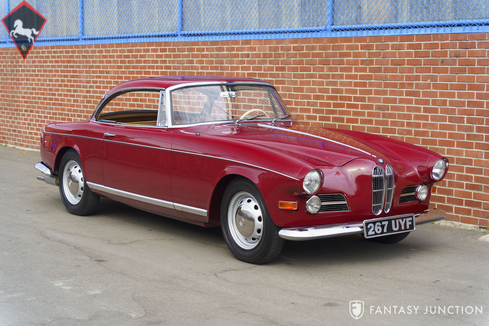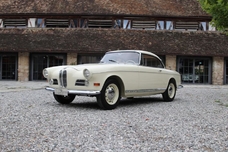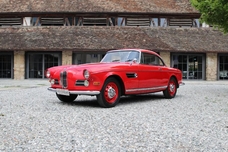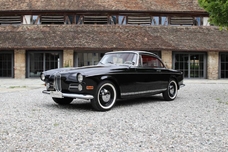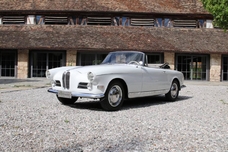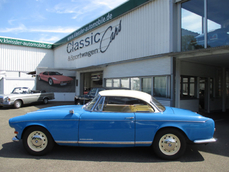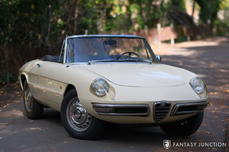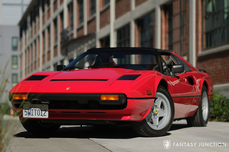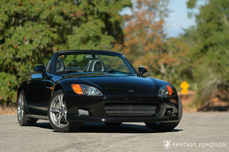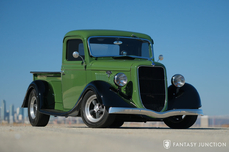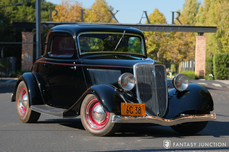BMW 503 V8 1957
General description :
1957 BMW 503 Coupe with Sunroof
s/n 69159, eng. no. 30177
Wine Red with Biscuit Leather Interior
BMW automobile production originally began under licensed manufacturing for a variety of other cars. And while early BMWs were merely a glimpse of what would evolve to become a premier luxury-performance brand, many remarkable sports cars like the Mille Miglia winning 328 would surprise the world with performance and elegance revealed in the combined production of the 503 and 507.
Enticed by Austrian importer Max Hoffman and BMW sales manager Haans Grewenig, BMW became convinced that premier GT and sports cars would appeal to wealthy North American clientele. Though competition was stiff, Hoffman envisioned a growing market of affluent performance GT enthusiasts building in the states. Though initially conceived with modest price tags, the 503 arrived substantially over budget even though many of the mechanical components had already been developed for the 501 and 502 luxury sedans. Simply stated, BMW's proud over-engineering and demanding internal requirements for excellence would not be compromised. Even the hand-crafted aluminum body, built at BMW Karrosserieentwurf, was assembled at great cost, including a cast alloy dashboard, itself a work of art.
Delivered to production at enormous internal expense from 1956-1959, the 503 offered features and performance that competed handily with contemporary offerings. But the costly 503, produced alongside the 507, was constructed to such exacting standards it nearly forced BMW into bankruptcy. Although a fiscal challenge for BMW, the 503 would generate important brand equity for BMW, but sales were less than expected, a result, while challenging at the time, that has since become woven into the rarity of these cars. Built with the finest mechanical components, the overhead valve 3.2 liter V8 aluminum block engine, upgraded with twin carburetors and improved lubrication via chain-driven oil pump, delivered 140 hp in a light and nimble package. And while performance was impressive for the time, the remarkable feature of the 503 was the undeniably beautiful handmade aluminum coachwork, penned by designer Albrecht von Goertz, who concurrently designed the celebrated 507 roadster.
Available in both coupe and convertible variants, the chassis was developed using a ladder frame derived from the 502. Steering and suspension from the 502 were also utilized with some improvements incorporated to the front suspension system. The gearbox and drum brakes were further derived from the 502 with front disc brakes becoming available in 1957, courtesy of John Surtees who had suggested this change for both the 507 and the 503, both of which Surtees owned. Offered with power windows, the same hydraulic unit that powers the electric convertible top and side windows, also powers the windows in the coupe.
While the 507 today has soared to millions of dollars in value, among enthusiasts, the 503 offers many similar attributes including superb leather interior, coachbuilt alloy bodywork, and touring performance with the added pleasure of luggage space and room for rear seat passengers. Further still, the 503 presents as a stunning value, a tenth of the cost of a comparably restored 507.
This 503 is one of 274 Coupes produced during the three-year production. According to the BMW Classic Certificate, this car was manufactured June 24, 1957, and delivered new to Imperial Garage, Paris, France. The exterior was finished in Weinrot (Wine Red) with a Becker Le Mans radio and automatic antenna. The certificate lists the chassis number, 69159, and engine number, 30177, both of which match numbers on the car today. Discovered in France after long term storage in a dry barn, the car was reportedly repainted blue in 1971. Offered for sale in Val-d’Oise, France (2013) as a complete example, it still retained the blue paint and was partially disassembled at time of sale. Currently fitted with a sunroof and front disc brakes, the fender line evokes the 507, sweeping rearward to a tightly tailored rear end offering ample space for touring event luggage and accessories. According to the current owner, this BMW was commissioned in Europe to a high-quality restoration spanning 2016-2021 at a cost exceeding $110,000. The restoration is documente with a tabulated history of work, costs, and vendors. Photos and reference information from the owner indicate the paint was hand stripped to best preserve the original aluminum body panels. Alloy repair work was performed by hand and the chassis media blasted in preparation for paint. The engine was rebuilt using new forged pistons, new bearings matched to the machined crankshaft, the valves replaced, and the heads renewed. Top vendors supplied correct parts, proper materials, and the various specialty work was performed by teams of people familiar with BMWs from this era. In September 2022, the oil was changed to 30W and the hydraulic window lift system was drained of fluid and DOT3 brake fluid was installed with a new cork gasket, resealing the line fittings. The choke cables were adjusted, carburetor idle speed reset, and the accelerator linkage lubed.
Today this BMW 503 presents as a captivating and beautifully restored example finished in deep red with elegant biscuit leather interior. The paint is glossy and smooth, flowing gracefully over the alloy body panels. The fine body details, delicate features, and exquisite surface transitions are beautifully finished. The doors, hood, and trunk gaps are excellent, opening and closing smoothly, with jambs and underside surfaces showing excellent finish consistent with the exterior quality. The front and rear bumpers, headlight bezels, and other chrome features offer captivating reflections and glints of jewel-like detail without interrupting the stunning Goertz design. The headlights, lenses, glass, and trim are finished to a very high standard with excellent fit. The distinctive BMW emblems are the only indications that viewers are not gazing at one of the finest Italian designs. Indeed, upon the debut at the 1955 Frankfurt Motor Show, even Battista “Pinin” Farina pronounced the 503 as the prettiest car in the entire show.
The sporty ventilated wheels are correctly finished in silver with small hubcaps bearing the embossed BMW logo. A set of period correct Michelin tires add to the sporting presence. The distinctive BMW split grille is polished to a high luster with precision fit to the openings and correct polish to the vertical trim. The hood is finished with a delicate central chrome trim spear, once again holding a fine line of elegance and purity in the design. The pillarless coupe roofline must rank among the best-looking canopies ever constructed on a long wheelbase platform.
The interior is beautifully presented with rich, taut biscuit leather, offering an elegant color and contrast to the red finish that commands any viewer's attention. The leather is beautifully textured, stitched, and tailored with exceptional quality including lightly tufted pleats, excellent piping, leather wrapped armrests, and smooth seating contours. Overall, the interior is elegantly trimmed throughout with no evidence of wear to the leather surfaces. The correctly trimmed and border-piped low pile carpeting is in excellent condition, showing only mild evidence of use confined to the driver’s footwell. The dashboard sports an elegant array of vividly restored gauges with crisp lettering and bright numeric indication. Further details include a Becker Mexico radio, leather covered dashboard, and a gorgeous four-spoke ivory white steering emulating, as their logo does, the high-speed prop spin marking BMW’s aviation heritage. The stunning and elegant interior continues to the trunk lining and finishes in the trunk compartment which offers ample room for luggage along with a full-sized matching spare wheel. Here too, one can admire the attention to detail given to the underside trunk finish and inner side panels.
Under the hood, the BMW V8 engine is correctly detailed utilizing original accessories and properly finished hardware. The engine number, 30177, is consistent with numeric engine sequences reflective of factory installation and is further identified as the engine number on the BMW Classic Certificate. Both the engine and engine compartment have been restored and detailed to a high standard including the silver painted engine and accessories, cast iron exhaust manifolds, correctly finished twin carburetors with stamped metal air cleaners, factory labels, correct wiring, and proper hardware. The engine presents very well even under show-level scrutiny as both cosmetic and operational diligence is evident with just a few hints of modest post-restoration use. A set of tools resides in a dedicated BMW storage box. Inspection of the undercarriage further validates the quality of the restoration applied with care and once again, attention to factory specifications.
In addition to the visual condition, this BMW 503 offers both mechanical refinement and operational confidence. The car starts and runs smoothly, benefiting from recent service to the fuel system and fuel tank. The delicately muffled V8 engine is brisk and responsive moving through all four speeds. The comfortable seating position offers expansive visibility and easy to reach controls further enhanced by the pillarless design and sunroof. Driving this BMW 503 it is easy to see how these cars delighted the few but fortunate owners who purchased them new despite the considerable financial losses BMW experienced lavishing the very best in quality which nearly resulted in their demise. This beautiful BMW 503 is accompanied by an original BMW 503 owner’s manual, BMW service books, and chassis diagram.
Rare in number and recognized by discerning connoisseurs as the elegant partner to the BMW 507 roadster, the 503 remains today as a superb example of automotive beauty and sophisticated elegance. Representing the dawn of the BMW legacy in North America and eventually the world, this beautiful example serves as a reminder to the initial uncompromising excellence that BMW offered in their GT cars. Beautifully restored, sunroof equipped, and one of 274 built, this alloy bodied BMW 503 is sure to delight enthusiasts for years to come.Please note this vehicle is sold duty paid in the USA on an English V5 ownership document in the name of the consignor.
https://fantasyjunction.com/inventory/1957-bmw-503-sunroof-coupe/overview
1957 BMW 503 V8 is listed sold on ClassicDigest in Emeryville by Fantasy Junction for $250000.
Car Facts
Car type : Car Make : BMW Model : 503 Model Version : V8 Engine size : 0.0 Model Year : 1957 Location : Emeryville Vehicle Registration : Normal
Sold
Seller Information
Sold
People who viewed this BMW 503 also viewed similar BMW listed at ClassicDigest
Other cars listed for sale by this dealer
About BMW
ChatGPT
Bayerische Motoren Werke, commonly known as BMW, has a rich history dating back to its founding in 1916. Initially established as an aircraft-engine manufacturer during World War I, BMW faced restrictions on aircraft production after the war. In response, the company shifted its focus to motorcycle production in 1923, marking the beginning of its involvement in the automotive industry. Subsequently, BMW entered the world of automobiles in 1928 by producing the DIXI, essentially a licensed version of the Austin 7 from the Austin Motor Company.
In the 1930s, BMW began to establish itself as a manufacturer of elegant and high-performance vehicles. One notable model from this era is the BMW 327, introduced in 1937. The 327 was available as both a coupe and a cabriolet, showcasing the brand's commitment to luxury and style. Additionally, BMW achieved success in sports car racing during this period, particularly with the BMW 328. The 328, which debuted in 1936, became renowned for its performance and aerodynamics. BMW campaigned the 328 in various racing events, including the prestigious Mille Miglia, where the company introduced several aerodynamic specials.
The post-war era proved challenging for BMW, and the company faced financial difficulties that nearly led to bankruptcy. However, BMW managed to recover and rebuild, eventually becoming one of the leading premium automotive brands globally.
As the 1960s unfolded, BMW further solidified its reputation for producing sports-oriented and luxurious vehicles. In 1968, the BMW 2002 was introduced, marking the birth of the "New Class" of compact, sporty sedans. The 2002 gained popularity for its agile handling and performance, laying the foundation for BMW's sporty image.
Moving into the 1970s, BMW expanded its lineup with the introduction of the E9 platform, which included the iconic BMW 3.0 CS coupe. The E9 series showcased BMW's commitment to blending performance and luxury. In 1972, the M1, BMW's first mid-engined sports car, made its debut. The M1 was initially developed as a racing car but later became a road-going model. The M1 laid the groundwork for BMW's high-performance M series.
In the late 1970s, the BMW E24 6 Series was introduced, offering a combination of luxury and performance. The 6 Series included models like the 630CS, 633CSi, and 635CSi, becoming a symbol of sophistication and driving pleasure.
Through these milestones and a commitment to innovation and performance, BMW has evolved into a powerhouse in the automotive industry, maintaining its status as one of the leading premium brands worldwide.
